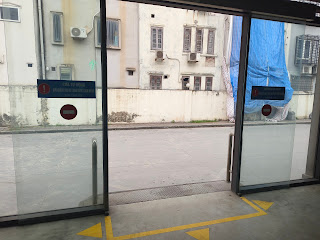Amongst numerous metros and a single monorail, Kuala Lumpur has a single bus rapid transit (BRT) line. It is shown on the city's integrated transit maps as the line B1 - Sunway line. The name reflects the fact it largely serves the Sunway development which includes residential and retail and a university, and was part funded by Sunway.
The Sunway line is largely elevated dedicated transitway. It has access ramps for buses to from depot s and service vehicles but is not integrated with any other local buses. The layout means that it can only practicably be used by BRT Sunway line services, although there is interchange with other local buses en route.
There is no dedicated guidance infrastructure nor unusual step height, which means that, theoretically, any local bus could be used on Sunway line services. However a small fleet BYD electric buses are dedicated to the service, based on their K9 model with a bespoke body and interior. They are operated by Rapid KL, as are most other urban public transport services in Malaysia's capital.
There are seven stations on the BRT Sunway line, all of which are elevated and feature 100% off bus ticketing, with ticket barriers managing access to and from the platforms. They are equipped for a local electronic ticketing scheme which offers cheaper fares than the cash fares from ticket machines and includes both pay-as-you-go and season tickets. There is no ability to accept bank or credit cards for pay-as-you-go payment on the BRT or any other Kuala Lumpur metro/bus service. The southern terminus at USJ7 station (yes, that is it's name) offers paid side interchange with the metro line 5.
This selection of photos illustrates the Kuala Lumpur Sunway BRT line and shows how the basic BRT brief of journey time reliability and reduction has been delivered, with no interference from any other traffic including other buses - which means the infrastructure benefits are only afforded to Sunway line passengers.
 |
| Paid side interchange at USJ7 |
 |
| USJ7 station BRT platform. Guard rails were at some but not all BRT stations leading to the buses with a centre door for boarding and alighting. The addition of tensa-type barriers is a common post-construction feature of transport infrastructure across south east Asia when they work out how they actually want to operate a site! |
 |
| Elevated busway approaching USJ7. No guidance (etc) equipment is required on vehicles. |
 |
| One of the BYD K9 electric buses approaches USJ7. |
 |
| Boarding and alighting is through a centre door with 100% off bus ticketing. |
 |
| Interior seating layout is in a large bay. |
 |
| Busway |
 |
| Typical platform, this one has barriers added post-constriction to lead to the door location. |
 |
| Access to the Sunway line bus. |
 |
| Service vehicles can also access the infrastructure easily. |
 |
| Staffed office and ticket barriers managing access to/from the platforms. |
 |
| The elevated busway and BRT station. |
 |
| Interior layout. |
 |
| Forward section is largely for standees |



















































